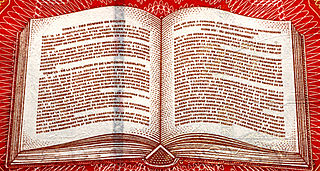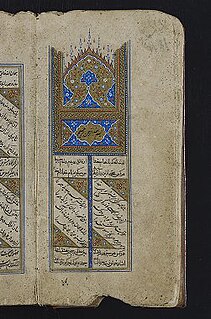Related Research Articles

Alexandrine is a name used for several distinct types of verse line with related metrical structures, most of which are ultimately derived from the classical French alexandrine. The line's name derives from its use in the Medieval French Roman d'Alexandre of 1170, although it had already been used several decades earlier in Le Pèlerinage de Charlemagne. The foundation of most alexandrines consists of two hemistichs (half-lines) of six syllables each, separated by a caesura :
o o o o o o | o o o o o o o=any syllable; |=caesura
The elegiac couplet is a poetic form used by Greek lyric poets for a variety of themes usually of smaller scale than the epic. Roman poets, particularly Catullus, Propertius, Tibullus, and Ovid, adopted the same form in Latin many years later. As with the English heroic couplet, each pair of lines usually makes sense on its own, while forming part of a larger work.

An epigram is a brief, interesting, memorable, and sometimes surprising or satirical statement. The word is derived from the Greek ἐπίγραμμα epígramma "inscription" from ἐπιγράφειν epigráphein "to write on, to inscribe", and the literary device has been employed for over two millennia.
In poetry, metre or meter is the basic rhythmic structure of a verse or lines in verse. Many traditional verse forms prescribe a specific verse metre, or a certain set of metres alternating in a particular order. The study and the actual use of metres and forms of versification are both known as prosody.

Poetry, also called verse, is a form of literature that uses aesthetic and often rhythmic qualities of language − such as phonaesthetics, sound symbolism, and metre − to evoke meanings in addition to, or in place of, a prosaic ostensible meaning. A poem is a literary composition, written by a poet, using this principle.
A rhyme is a repetition of similar sounds in the final stressed syllables and any following syllables of two or more words. Most often, this kind of perfect rhyming is consciously used for a musical or aesthetic effect in the final position of lines within poems or songs. More broadly, a rhyme may also variously refer to other types of similar sounds near the ends of two or more words. Furthermore, the word rhyme has come to be sometimes used as a shorthand term for any brief poem, such as a nursery rhyme or Balliol rhyme.

Modern lyric poetry is a formal type of poetry which expresses personal emotions or feelings, typically spoken in the first person. It is not equivalent to song lyrics, though song lyrics are often in the lyric mode, and it is also not equivalent to Ancient Greek lyric poetry, which was principally limited song lyrics, or chanted verse, hence the confusion. The term for both modern lyric poetry and modern song lyrics both derive from a form of Ancient Greek literature, the Greek lyric, which was defined by its musical accompaniment, usually on a stringed instrument known as a kithara. The term owes its importance in literary theory to the division developed by Aristotle between three broad categories of poetry: Lyrical, dramatic, and epic. Lyric Poetry is also one of the earliest forms of literature.

The ghazal is a form of amatory poem or ode, originating in Arabic poetry. A ghazal may be understood as a poetic expression of both the pain of loss or separation and the beauty of love in spite of that pain.
Articles related to literature include:
Parallelism is a rhetorical device that compounds words or phrases that have equivalent meanings so as to create a definite pattern. This structure is particularly effective when "specifying or enumerating pairs or series of like things". A scheme of balance, parallelism represents "one of the basic principles of grammar and rhetoric".
Kuṟuntokai is a classical Tamil poetic work and traditionally the second of the Eight Anthologies (Ettuthokai) in the Sangam literature. The collection belongs to the akam (love) category, and each poem consists of 4 to 8 lines each. The Sangam literature structure suggests that the original compilation had 400 poems, but the surviving Kuruntokai manuscripts have 402 poems. According to Takanobu Takahashi – a Tamil literature scholar, these poems were likely composed between 100 CE and 300 CE based on the linguistics, style and dating of the authors. Kamil Zvelebil, a Tamil literature and history scholar, states that the majority of the poems in the Kuruntokai were likely composed between the 1st century BCE and the 2nd century CE. The Kuruntokai manuscript colophon states that it was compiled by Purikko (உரை), however nothing is known about this compiler or the patron.
This is a glossary of poetry.

The Pashto media includes Pashto literature, Pashto-language newspapers, magazines, television and radio stations, as well as Pashto films and Pashto internet. Pashto media involves the Pashtuns of Pakistan, Afghanistan and the Pashtun diaspora around the world.

Eliza Griswold is a Pulitzer Prize-winning American journalist and poet. Griswold is currently a contributing writer to The New Yorker and a Distinguished Writer in Residence at New York University. She is the author of “Amity and Prosperity: One Family and the Fracturing of America,” a 2018 New York Times Notable Book and a Times Critics’ Pick, for which she won the Pulitzer Prize for general nonfiction and the Ridenhour Book Prize in 2019. Griswold was a fellow at the New America Foundation from 2008 to 2010 and won a 2010 Rome Prize from the American Academy of Arts and Letters. She is a former Nieman Fellow, a current Berggruen Fellow at Harvard Divinity School, and has been published in The New Yorker, Harper's Magazine, and the New York Times Magazine.

Pashto music or Də Pəx̌tó ṭang-ṭakór is commonly performed in Afghanistan and Pakistan among Pashtun people.
Nāzo Tokhī, commonly known as Nāzo Anā, was an Afghan poetess and a writer in the Pashto language. Mother of the famous early-18th century Afghan King Mirwais Hotak, she grew up in an influential family in the Kandahar region. She is remembered as a brave woman warrior in Afghan history and as the "Mother of the Afghan Nation".

Classical Chinese poetry forms are poetry forms or modes which typify the traditional Chinese poems written in Literary Chinese or Classical Chinese. Classical Chinese poetry has various characteristic forms, some attested to as early as the publication of the Classic of Poetry, dating from a traditionally, and roughly, estimated time of around 10th–7th century BCE. The term "forms" refers to various formal and technical aspects applied to poems: this includes such poetic characteristics as meter, rhythm, and other considerations such as vocabulary and style. These forms and modes are generally, but not invariably, independent of the Classical Chinese poetry genres. Many or most of these were developed by the time of the Tang Dynasty, and the use and development of Classical Chinese poetry and genres actively continued up until the May Fourth Movement, and still continues even today in the 21st century.

Afghan literature or literature of Afghanistan refers to the literature produced in the Islamic Emirate of Afghanistan. Influenced by Central and South Asian literature, it is predominantly written in two native and official languages of Afghanistan, Dari and Pashto. Some regional languages such as Uzbek, Turkmen, Balochi, and Pashayi also appears in Afghan literature. While Afghanistan is a multilingual country, these languages are generally used as oral compositions and written texts by the Afghan writers and in Afghan curriculum. Its literature is highly influenced by Persian and Arabic literature in addition to Central and South Asia.
I Am the Beggar of the World: Landays from Contemporary Afghanistan is a 2014 collection of over 100 landays written by female Afghans, and translated into English by Eliza Griswold. The book also includes images taken by Seamus Murphy. The collection was generally well received, winning the 2014 PEN Award for Poetry in Translation. Critics praised the window the poems offered into the lives of women in Afghanistan as well as Murphy's photographs and other contextual materials included by Griswold.
Mirman Baheer is a secret literary society of women meeting across Afghanistan. Founded in 2010 by Sahira Sharif, the organization attracted international attention after research conducted by Eliza Griswold was published in 2012. It has continued to meet into 2021, shifting to livestreaming meetings during the COVID-19 pandemic.
References
- "Landay" in Glossary Terms. Poetry Foundation, n.d. Web. 19 Feb. 2016 Web access
- Brooks, Mary Jo. "Pulling Back the Burka: A Glimpse of Afghan Life Through Poetry." Pulitzer Center on Crisis Reporting. Pulitzer Center, 20 June 2013. Web. 19 Feb. 2016.
- Griswold, Eliza. "LANDAYS." Poetry Foundation. Trans. Asma Safi. Poetry Foundation, n.d. Web. 19 Feb. 2016.
- Cestari, Elisa. "Landay Poetry in Afghanistan." Muftah. Muftah, 06 Aug. 2014. Web. 19 Feb. 2016.